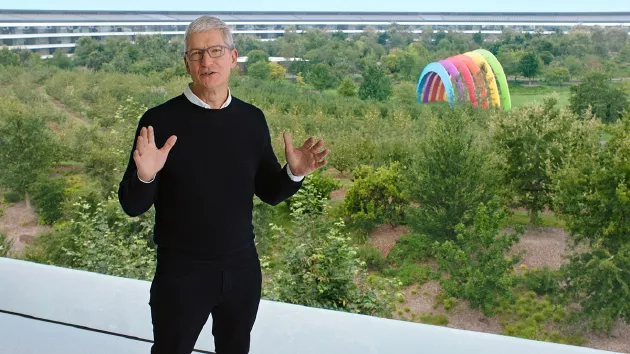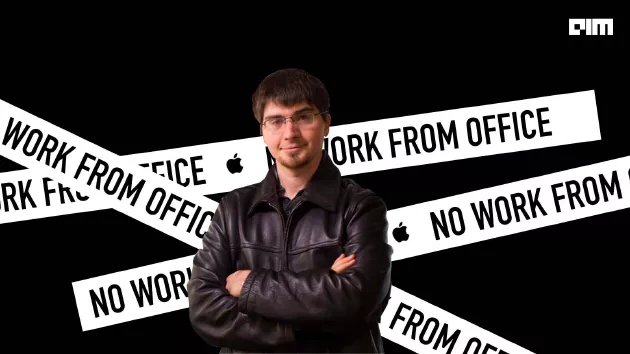Over the past year, Apple has postponed its comprehensive return to work plan several times. The headache for Apple executives is that every time they put forward the resumption plan, they will be strongly opposed by a large number of employees, and even threatened to resign. The final compromise was apple, the employer, and once again postponed the schedule of returning to work.

Cook really wants his employees to go back to work
Sina Technology Zheng Jun from Silicon Valley
Perhaps cook could not help feeling: why is it so difficult to get employees back to work?
Apple once again compromises
Over the past year, Apple has postponed its comprehensive return to work plan several times. The headache for Apple executives is that every time they put forward the resumption plan, they will be strongly opposed by a large number of employees, and even threatened to resign. The final compromise was apple, the employer, and once again postponed the schedule of returning to work.
According to the step-by-step rework arrangement announced by apple in March this year, most employees return to the company for one day a day from April 11, and return to the office three days a week on May 23 (flexible choice on Wednesday and Friday). But Apple also allows employees to work remotely for up to four weeks a year.
This is the fourth time Apple has announced its resumption plan in a year. It seems that cook's attitude is firm this time. "This is a long-awaited milestone and a positive signal that we can interact with our colleagues more comprehensively." However, perhaps cook himself did not expect that he could not achieve his goal this time.
Last week, apple again announced the suspension of its comprehensive return to work plan for employees to return to the office. According to the latest resumption plan, some employees go back to work two days a week. If they feel "uncomfortable" in the company, they can also choose to work remotely. Apple also said that the company would closely monitor the changes of the epidemic situation and evaluate and adjust its work policies every two weeks. The news was welcomed by thousands of employees who did not want to go back to work.
Musk, the ubiquitous world's richest man and opinion leader, did not miss the opportunity to ridicule apple. He forwarded the news of Apple's plan to postpone employees' return to work, and attached a picture of a fat, sleepy dog, which said "put on your gym clothes and watch TV", mocking Apple employees' reluctance to return to work because they are lazy.
Musk has hated apple for a long time. When Apple poached Tesla employees in 2015, he publicly mocked that "apple is Tesla's cemetery", meaning that employees who can't get along with Tesla will go to apple. When Tesla was at a low point in 2018, musk tried to talk to Apple about the acquisition, but cook didn't want to see him at all. Of course, later, Tesla's share price soared several times, and musk became the richest man in the world. He also had a proud capital.
Maybe musk can't understand the concessions made by Internet companies to employees again and again. After all, Tesla's corporate culture is efficient execution; He has never concealed his appreciation for the efficiency and productivity of Chinese factories. Last month musk even joked that Twitter headquarters would be transformed into a homeless shelter, because most twitter employees choose to work remotely, leading to the emptiness of Twitter's huge headquarters in downtown San Francisco.

Technical backbone resigns to protest
The topic goes back to apple. As in previous times, the reason for the withdrawal of the policy by Apple executives this time is also from internal and external pressure. After Apple announced its return to work plan, an online group called "apple together" issued an open letter calling on Apple's management to reconsider the so-called mixed work arrangement, give employees more flexibility to arrange their workplaces, and use slack and other online collaboration tools for telecommuting to relieve employees of the burden of commuting back and forth.
Sina Technology saw at the bottom of this open letter that there were more than 3000 signatures, including 1445 former and current Apple employees (not named), accounting for less than half of the total number of signatures. In other words, only a few hundred employees may sign here. If retail store employees are included, Apple has more than 100000 employees in the United States.
Surprisingly, whether to return to the office or not was originally an internal matter of apple, but these employees chose to put pressure on Apple's management through external public opinion in the form of external open letter, rather than giving feedback to senior management through internal channels. This seems to run counter to Apple's consistent culture of confidentiality.
Are Apple employees really so resistant to going back to work? An employee of Apple's hardware R & D department told Sina technology that at least his colleagues around him did not show such great resistance; Apple has tens of thousands of employees, and only a few strongly oppose going back to work. They just stand up and speak out publicly, attracting media reports and exerting some pressure on the management.
Perhaps, Apple executives are more worried about the brain drain. This "inflexible way of working" corporate image will not only affect Apple's recruitment of excellent technical talents, but also lead to the loss of existing technical backbone. When Apple announced its step-by-step resumption plan last summer, many employees threatened to resign. It seems that these people are not just talking.
Earlier this month, Ian Goodfellow, Apple's director of machine learning, announced his resignation. The direct reason for his resignation was Apple's return to work policy. "I firmly believe that more flexibility should have been the best policy of my team," Goodfellow wrote in his resignation letter to department employees
The news not only attracted media attention, but also alerted Apple management. Although he is only 36 years old, Goodfellow is not an ordinary technical talent. He is a recognized industry technical expert in the field of AI and the designer of generative countermeasure network (GAN). The generation of confrontation network means that the two neural networks learn from each other in the form of game, which brings disruptive innovation to machine learning technology.
In 2019, apple spent a lot of money to recruit Goodfellow from Google to serve as the machine learning technology director of the special projects group. This special project department is Apple's new product R & D department, reporting directly to cook; Although the specific work cannot be disclosed, it is speculated that Goodfellow is likely to be responsible for the automatic driving technology of Apple cars.
At this Daniel level, salary is no longer the main consideration, and whether you are comfortable with your work is the focus. A few years ago, Goodfellow earned more than $1 million a year at Google. Now, because of dissatisfaction with Apple's return to work policy, Goodfellow has chosen to return to Google again (this is his third time at Google) and joined the deepmind team of the parent company, alphabet. This reason for leaving does embarrass apple.
Free choice of remote work
So why are those Apple employees so resistant to going back to work? Of course, the epidemic is a direct reason. The Omicron variant is still spreading rapidly. Santa Clara County, where Silicon Valley is located, has a population of 2 million, with an average increase of more than 1000 people in seven days.
But on the other hand, it seems that Americans don't care about Omicron with mild symptoms at all. Restrictions have been lifted across the country, and the strictest silicon valley no longer requires indoor masks. The 101 highway in Silicon Valley is congested every day, and shopping malls and restaurants are crowded. Now that daily life has returned to normal, why don't you want to return to the office?
According to a survey of teleworkers conducted by Bay area news group in November last year, the main reasons why they do not want to go back to work include: unwilling to tolerate commuting (80%), worried about the epidemic (63%), self-determination of working hours (59%) and more comfortable at home (55%). Nearly half of the respondents think it is more efficient to work from home, but half also admit that the collaboration efficiency in the office is really high.
Another employee of Apple's software department told Sina technology that he had no resistance to going back to work, but what many people were dissatisfied with was not that they had to go back three days a week, but that the company did not allow everyone to choose telecommuting freely. This is the biggest difference between Apple's resumption policy and other large enterprises. Apple employees are dissatisfied with the lack of flexibility and autonomy.
Of course, there are internal reasons why Apple actively promotes going back to work. Unlike Internet companies such as meta and twitter, Apple's integrated software and hardware research and development requires more internal collaboration and higher confidentiality requirements. Therefore, cook hopes that employees can return to the office to work. After the outbreak of the COVID-19, Apple's R & D work has also been significantly hampered and delayed due to the employees' inability to travel smoothly between China and the United States. In 2020 iphone The delay in release is a direct impact. Before the outbreak, apple sent hundreds of engineers from its headquarters to work in China every month.
But they all work in Silicon Valley, and there is a gap only when there is comparison. In this regard, employees of Internet companies such as Google and meta do enjoy more freedom. Goodfellow returned directly from apple to Google, which highlights the gap in this regard. A Google headquarters employee revealed that although Google announced the mixed working system as early as April and hoped that employees would return to the company three days a week, this is not mandatory. Employees can decide by themselves, "just say hello to the boss when they don't want to go to the company. It's the same at home anyway."
Moreover, Google employees have more choices. They can apply for a period of time or long-term telecommuting, or they can change their mind and apply to go back to work in the company. However, compared with the empty office space of the apple spaceship headquarters (COVID-19 was encountered one year after the official launch), the office space of Google headquarters is relatively tight, and it is not so easy to go back to work.
"If you apply for long-term remote work, your station may be assigned to other colleagues, and then you don't necessarily have a vacancy if you want to come back to work. The company has recruited a lot of people in the past two years, and many newcomers don't even have their own jobs," the Google headquarters employee explained
Working mode has changed
Since the full outbreak of the epidemic in March 2020, employees of many technology enterprises in Silicon Valley have been working at home for more than two years, and their pace of life and way of work have changed accordingly. Many people have left Silicon Valley, moved to the surrounding areas a few hours' drive, and even moved to other states. Now let them go back to the office and get used to experiencing the pressure of high-speed commuting twice a day in the morning and evening. This change is not so easy to accept.
For many technology company employees, this choice is very natural and practical, especially for young people without children. Since you are allowed to work from home, you can work anywhere. Why do you have to endure the high prices and rents in Silicon Valley?
The data won't lie. From 2020 to 2021, San Francisco's emigration population reached 56000, a decline of 6.3%, which is the region with the highest rate of population outflow in the United States, second only to 6.6% in New York. San Mateo County in Silicon Valley ranks fourth in the United States with 3.2% of the migrant population, and Santa Clara County has 2.3% of the migrant population. Nearly 50000 people choose to move their families. In contrast, Dallas, Houston, Austin and other cities in Texas had the largest population migration in the same period, and low taxes and prices obviously played an important role.
According to the apartment rent statistics report released by apartment list, despite the serious inflation in the United States in the past two years and the average rent in the United States has soared by 16%, the rent level in the San Francisco Bay area is not soaring, but lower than that before the cessation of the epidemic in March 2020. In a sense, Silicon Valley is one of the few places in the United States where the rent is still lower than it was two years ago.
Of course, this does not mean that Silicon Valley has become livable. In April this year, the average monthly rent of one bedroom in San Francisco was $2900, 3.3% lower than two years ago, and the rent of Santa Clara County in South Bay was 1.3% lower than two years ago. By contrast, rents in vacation retirement areas such as Miami, Florida, have soared 34 percent.
Amy, a young employee of meta, applied for telecommuting last year and moved from Silicon Valley to Denver, Colorado. Although this means a pay cut, she is very satisfied with it because she loves skiing. Because living in Silicon Valley, if you want to ski, you need to drive five hours to Taihao lake one way and pay high hotel fees on weekends. Colorado is a paradise for outdoor sports. She can enjoy herself around almost every weekend. "Going back to Silicon Valley? That's not my favorite life. Although I have less income here, my happiness in life has improved too much."

Living and working elsewhere
Although Internet companies such as Google, meta and twitter allow employees to apply for long-term telecommuting, leaving Silicon Valley also means accepting different salary cuts because tax rates are different in different regions. This makes many employees who want to live more comfortably and do not want to take less money hesitate. Airbnb, a shared home stay website, stands out with humanized policies in this regard and has become a leader in employee welfare.
Just as Apple employees protested with resignation and demanded the right to telecommuting, airbnb announced that it would allow employees to telecommute permanently, and no matter where they work, there is no need to reduce their salary. Brian Chesky, co-founder and CEO of airbnb, said that the office has become "the past of the pre digital era", "the office we understand is over, and now we must look forward."
Chesky made it clear that in the past two years, airbnb has allowed employees to work remotely, and the work efficiency has not been reduced, but improved. And allowing employees to choose their own office space will also help attract more talents. After airbnb announced full telecommuting, the number of hits on the recruitment page exceeded 800000. Obviously, everyone likes the benefits of airbnb. Working in any corner of the world can enjoy the salary of Silicon Valley.
But Chesky also acknowledged that the existence of the office still has its significance, which is the space for cooperation. However, he believes that the mixed working system of returning to work three days a week implemented by apple and other companies is unsustainable. Airbnb's choice is to let employees work together for a week every quarter so that they can cooperate more purposefully. No matter what working system is adopted, improving office efficiency and attracting talents to join are the first.
After all, the service of airbnb is to let people "live elsewhere", and it is logical to allow their employees to "work elsewhere". For a long time, Chesky, a billionaire worth more than $8 billion, has been "home all over the world", constantly "wandering" in various cities and experiencing his home stay services.